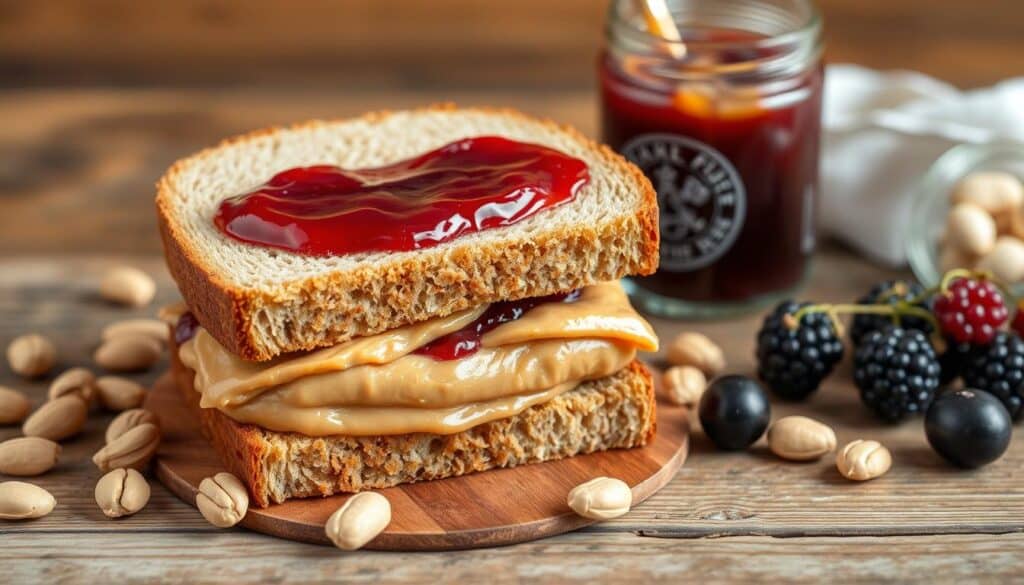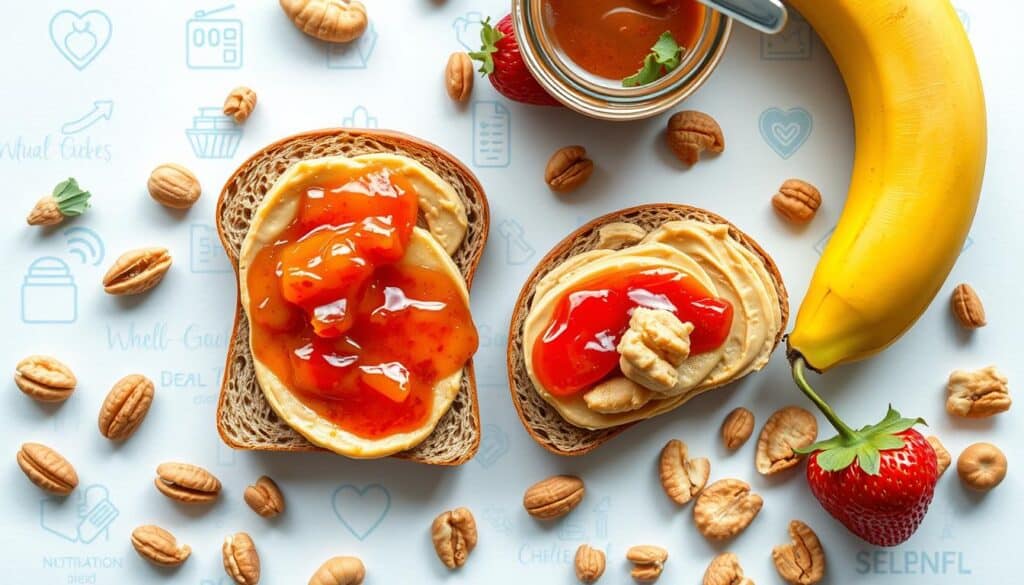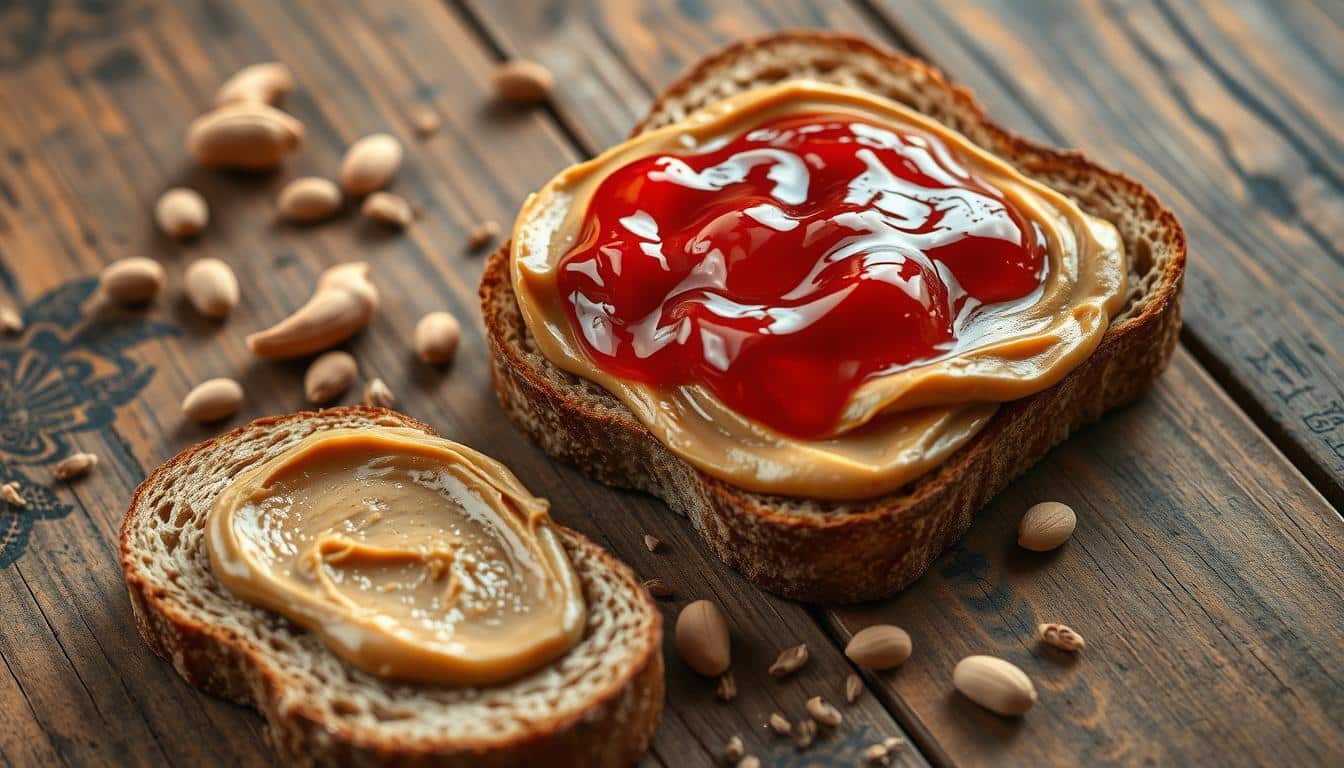Growing up, the smell of homemade bread grain peanut butter and jelly took me back to my childhood. It was more than just food. It was about the memories we made with every bite.
Our homemade sandwich spread is special. It’s packed with nutrients that make it a healthy choice. Each ingredient adds its own story of flavor and tradition.
We’re going to make a bread grain peanut butter and jelly recipe that’s more than just a sandwich. It’s a mix of old favorites and new health tips.
Key Takeaways
- Create a nutrient-dense sandwich using whole grain ingredients
- Master the perfect peanut butter to jelly ratio
- Understand the health benefits of natural, unprocessed ingredients
- Learn techniques to prevent soggy sandwich syndrome
- Explore creative variations of the classic PB&J
Essential Ingredients and Kitchen Equipment
Making tasty easy lunch ideas starts with knowing the right stuff. Our guide shows you how to turn simple items into snacks kids and adults will enjoy. Whether you’re new to cooking or a pro, the right tools matter a lot.
Basic Ingredients List
For a perfect sandwich, you need good ingredients. Here’s what you’ll need:
- Whole wheat bread (2 slices)
- All-natural peanut butter
- Fruit preserves or jelly
- Optional: Light brown sugar
- Salt
- Active dry yeast
Required Kitchen Tools
Having the right tools makes prep easier. Here are our top picks:
- Measuring cups and spoons
- Bread machine (optional)
- Butter knife
- Cutting board
Optional Add-ins and Variations
Try new things with your sandwich recipes. Here are some ideas:
| Ingredient Type | Variation Options |
|---|---|
| Nut Butter | Almond, cashew, sunflower seed butter |
| Bread | Cinnamon raisin, banana nut, sourdough |
| Spreads | Honey, cream cheese, marshmallow fluff |
For more dinner inspiration, check out our 15 Easy Ground Chicken Recipes for Quick Dinners, offering versatile and flavorful options. View Recipe.
“The secret to a great sandwich is using fresh, quality ingredients and letting your creativity shine!” – Kitchen Experts
Knowing these key ingredients and tools will help you make yummy PB&J sandwiches. They’re good for you and fun for everyone.
The History and Appeal of PB&J Sandwiches
The peanut butter and jelly sandwich is more than a meal. It’s a cultural icon loved by many. It started in the early 1900s in Manhattan tea rooms.
During the Great Depression, peanut butter sandwiches helped many families. They were affordable and nutritious. By World War II, the sandwich was in military rations, making it a part of American food.
“The average American will have eaten 1,500 PB&J sandwiches before graduating from high school” – A testament to its enduring popularity
- First known reference appeared in 1901 in the Boston Cooking-School Magazine
- 94% of Americans keep at least one jar of peanut butter at home
- Strawberry jelly remains the most popular flavor, chosen by 36.53% of consumers
PB&J sandwiches bring back childhood memories. They are perfect for school lunches or quick snacks. This simple sandwich is a comfort and a piece of American history.
Notable moments like the launch of Goober in 1968 and Peanut Butter & Co. in 1998 show its cultural importance.
Selecting the Perfect Bread Grain Components
Creating nutrient-rich ingredients for our bread is a careful process. We start by picking the right grain components. This is the first step in making protein-packed recipes.
Exploring Whole Wheat Flour Varieties
Whole wheat flour is key to making nutritious bread. We’ve found different types that add special qualities to our baking:
- White whole wheat flour: Lighter in color and milder in taste
- Traditional whole wheat flour: Robust and nutty flavor profile
- Sprouted whole wheat flour: Enhanced nutritional value
Vital Wheat Gluten: The Bread Structural Powerhouse
Our baking experts know vital wheat gluten is vital for perfect bread texture. It’s packed with protein. This helps our dough become elastic and gives our recipes structure.
| Wheat Gluten Type | Protein Content | Bread Performance |
|---|---|---|
| Vital Wheat Gluten | 75-80% | Excellent rise and texture |
| Standard Flour Gluten | 10-14% | Basic bread structure |
Understanding Baking Agents
Baking agents are key for making light, airy bread. Baking powder and baking soda help our ingredients turn into tasty, protein-rich recipes.
The secret to great bread lies not just in ingredients, but in understanding how they interact.
Bread Grain Peanut Butter and Jelly Recipe
Making the perfect homemade sandwich spread needs care and precision. Our easy PB&J recipe starts with top-notch ingredients. It follows a simple bread grain recipe to make your sandwich healthy.

- Gather your ingredients carefully
- Prepare your bread machine or mixing bowl
- Combine dry and wet ingredients systematically
- Knead the dough to perfect consistency
- Bake or prepare your bread
“A great sandwich begins with passion and quality ingredients” – Artisan Baker’s Wisdom
Our recipe is packed with nutrients:
| Nutritional Component | Amount per Serving |
|---|---|
| Calories | 321 kcal |
| Protein | 8g |
| Carbohydrates | 49g |
| Total Fat | 11g |
For a real homemade sandwich spread, use whole grain bread. Choose creamy peanut butter and natural fruit jelly. This mix is full of nutrients and tastes great.
- Use fresh, high-quality ingredients
- Select natural peanut butter without added sugars
- Choose low-sugar fruit jellies
- Experiment with different bread types
Creating the perfect PB&J is about mixing flavors and nutrition. Our recipe turns a simple sandwich into a healthy meal. It keeps you full all day.
Mixing and Baking Techniques
Making the perfect peanut butter and jelly sandwich is more than just spreading ingredients. We’ll show you how to make protein-packed recipes that take your sandwich to the next level. Our methods will help you make a meal that’s tasty and healthy.
Achieving the Perfect Dough Consistency
Getting the right texture is key for no-bake treats like our PB&J. Here are some important steps:
- Soften your bread slightly at room temperature
- Use a soft spreading technique for even coverage
- Warm peanut butter gently to improve spreadability
Mastering Baking and Assembly Techniques
Our sandwich doesn’t need baking, but we focus on precise assembly. The best layering is:
- Spread a thin, even layer of peanut butter
- Add jelly strategically to prevent bread sogginess
- Press gently to ensure ingredients adhere
“The secret to a perfect sandwich is balance and technique”
Our protein-packed recipes aim for a great balance of nutrition and taste. By focusing on these mixing and assembly techniques, you’ll turn a simple sandwich into a special treat.
Nutritional Benefits and Values

Our recipe is packed with protein and nutrients. Each serving of our Bread Grain Peanut Butter and Jelly sandwich gives you what you need for the day. It’s a balanced mix of essential nutrients.
This sandwich is very nutritious. Here’s what you get in one serving:
- 402 calories of energy
- 14 grams of protein
- 48 grams of carbohydrates
- 19 grams of healthy fats
“Nutrition isn’t just about calories, it’s about providing your body with quality fuel.” – Nutritional Expert
Our recipe uses whole grain bread. This makes the sandwich even more nutritious. Whole grains add fiber, vitamins, and minerals that refined bread doesn’t have.
| Nutrient | Amount per Serving | Daily Value % |
|---|---|---|
| Iron | 2.49 mg | 14% |
| Calcium | 114.24 mg | 9% |
| Potassium | 305 mg | 6% |
Peanut butter is key in our recipes. It adds healthy fats, B vitamins, and keeps you energized. We choose natural peanut butter to get the most nutritional benefits without extra additives.
Every bite of our sandwich is not just tasty. It also supports your health and wellness goals.
Storage and Serving Suggestions
Making homemade peanut butter and jelly bread is fun. It’s great for kid-friendly snacks and budget-friendly meals. Our recipe is full of flavor and easy to use for your family.
Optimal Storage Methods
Keeping your homemade bread fresh is key. Here are some tips:
- Store at room temperature in an airtight container for up to 3 days
- Refrigerate for up to a week
- Freeze for up to 3 months
Creative Serving Ideas
Our bread is perfect for many tasty snacks and meals:
- Classic PB&J sandwich (toasted or untoasted)
- French toast base
- Grilled cheese alternative
- Bread pudding ingredient
“A great bread is the foundation of endless culinary creativity!” – Home Cooking Enthuasiast
For the best taste, slice the bread when it’s cool. Pro tip: Wrap slices in parchment paper before freezing for easy serving.
Pairing Suggestions
Make your bread even better with these sides:
- Fresh fruit slices
- Yogurt
- Chocolate milk
- Vegetable sticks
Conclusion
We’ve looked into the world of bread grain peanut butter and jelly. It’s full of possibilities and good for you. We found out how to pick ingredients and mix flavors to make it special.
This homemade sandwich spread is great because you can change it up. It has protein from peanut butter, fiber from whole-wheat bread, and carbs from jelly. It’s good for you and can fit different diets.
Being creative is key to making the best PB&J. You can choose creamy or crunchy peanut butter, different breads, and jelly flavors. It’s all about finding the right mix for you.
The best PB&J is the one that makes you happy. It shows how much people love this classic American favorite.

